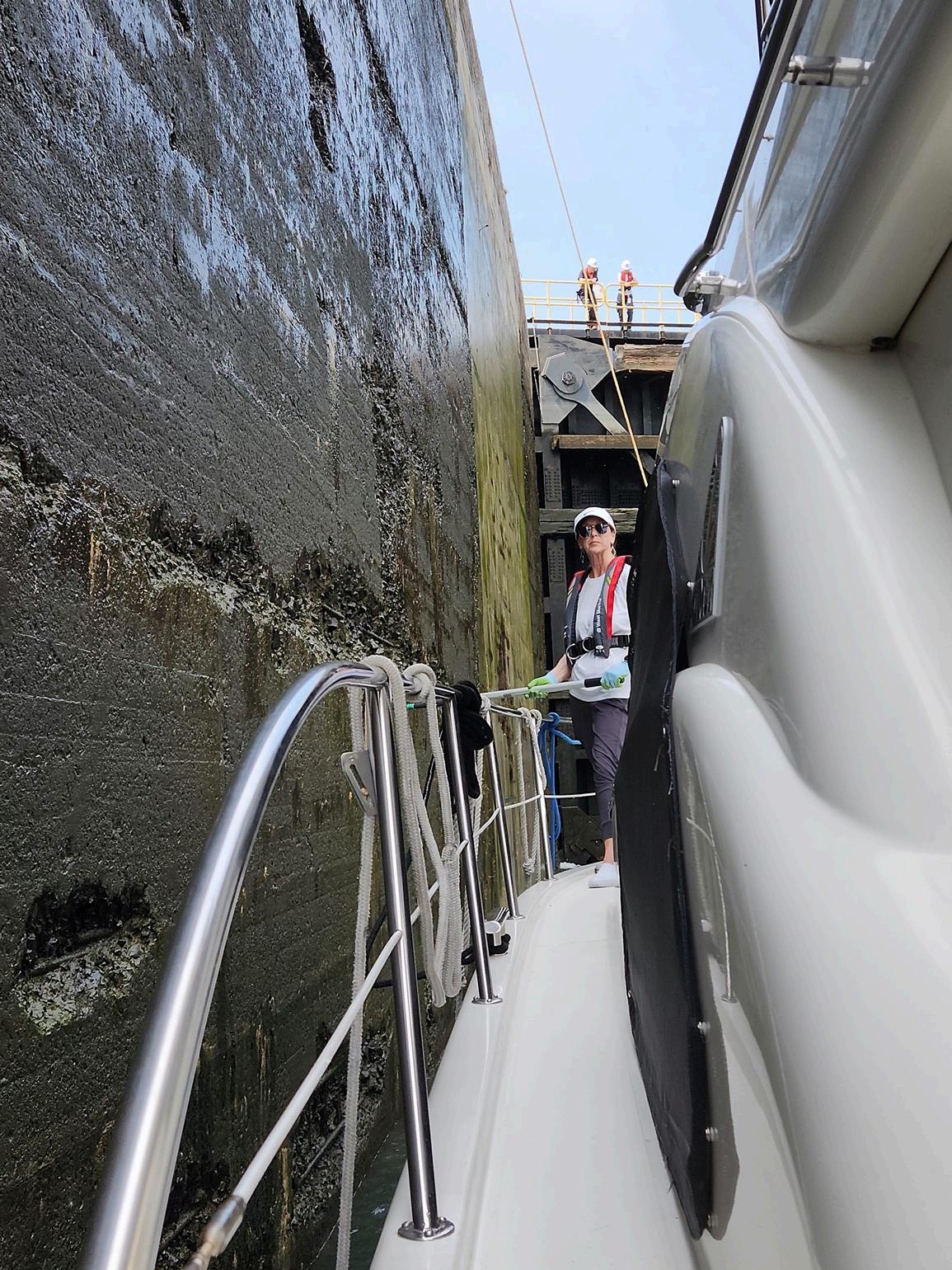
12 minute read
INTERNATIONAL DELIVERY
by theensign
Boaters bring their new boat home from Montreal to Seneca Lake
BY SHANE ALSWORTH OF AMERICA’S BOATING CLUB FINGER LAKES CHAPTER
► My wife, Jacqueline, and I cleared our calendars, grabbed fresh cups of coffee and set up camp in my office: We would devote the day to compiling a PowerPoint presentation for our Cruising Under Power and Sail class as well as studying for our final exam. Jacqueline and I wanted to learn everything we could in this course, especially because we would be embarking on our first-ever cruise in a few days, and our presentation represented our readiness for the trip. To add more anxiety to the mix, our final exam would take place aboard our new boat, trawling across the Erie Canal, with our instructor aboard the vessel distributing No. 2 pencils and exam booklets.
After several years of contemplating how to enter the hobby of boating, we made the adventurous decision to jump in with both feet and purchase a 39-foot cabin cruiser with twin diesel engines, two staterooms and two heads. To make our first boat purchase even more interesting, we found our Azimut 39 in Montreal. We would need to navigate an international purchase, delivery over the water and US customs Fortunately, our friend and class instructor, Tom Alley, would be captain on this delivery trip. Another friend, Don Kloeber, would help us with the delivery. Don and his wife, Marge, inspired us to take up the hobby, and they have been our personal Moses, leading us through the boating wilderness. Don was also our Cruising Under Power and Sail instructor and would administer a vessel safety check en route to Seneca Lake in New York.
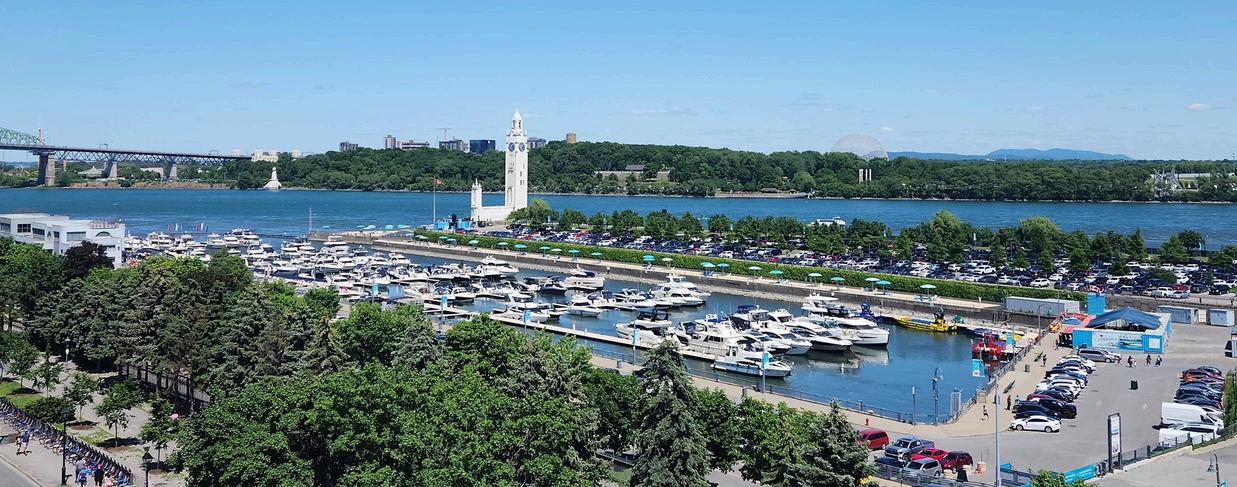
The timing of our cruise was perfect. We were diligently working through our Cruising Under Power and Sail course, and every new chapter gave us a list of items to prepare for our trip. Fortunately, our class presentation went well, and we learned a lot from the feedback we received.
Shortly after our presentation, we drove up to Montreal for our fourth and final trip to survey the boat. The seller had allowed us to use their slip in the Montreal Yacht Club for three days after closing to prepare for the voyage This gave us time to acclimate to the boat, find items that needed immediate repair and provision for our trip. We also found time to enjoy the beautiful Old Port section of the city, the many great restaurants and nightcaps on our new flybridge. Tom and Don arrived the night before we set sail and immediately went to work helping with last-minute preparations and reviewing logistics. The next morning, we had a nice breakfast and then pushed off the dock. We entered the St Lawrence Seaway, leaving the majestic Clock Tower in our wake.
Locking through the St. Lawrence Seaway
We prepaid lock fees for the day online and soon entered the St. Lambert lock, and in quick succession we made our way through the Côte-Sainte-Catherine lock. We marveled at the large commercial freight carrier ships we encountered and the engineering that makes these incredible locks function. We cruised through the locks with only one other recreational boat.
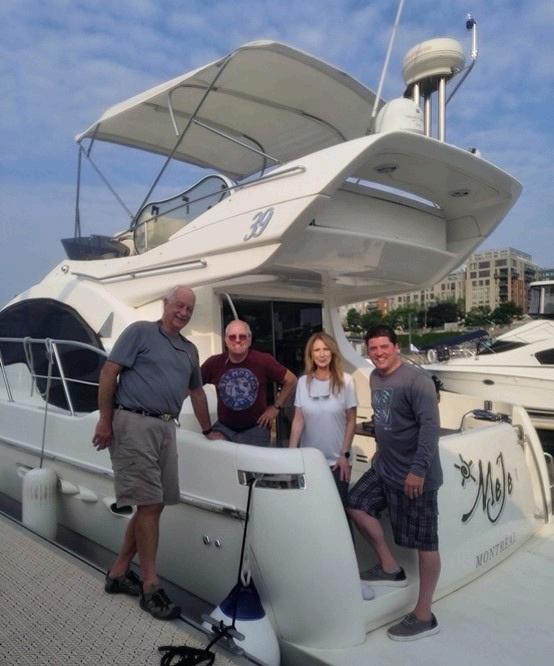
Tom and Don coached us through the process. Wrapping the tether lines that lock staff tossed to us around a cleat with one hand, we pushed off the wall with a boat hook in the other. Initially, we felt the need to use all our energy, as if we had to sacrifice our bodies to save our boat from scraping the lock walls. By the end of this trip, we were lazily handling our duties, mindful but not panicked. We made our way up to the Beauharnois locks, which had easy operation and friendly staff. After passing through the lower lock, we entered the upper lock, tied up and waited for the same staff members to arrive in their golf carts to help us through the second lock.
Later that afternoon, we came to the Saint-Louis-deGonzague lift bridge. There was no option to communicate with the bridge master, but we arrived well before the scheduled lift time for that day. We floated around, waiting for the green light until about 15 minutes after the bridge was scheduled to lift. There was virtually no vehicle traffic over the bridge, but there was also no commercial traffic waiting to go under the bridge. We eventually set anchor and lay out on the bow and flybridge to nap. About an hour later, the green light came on, and the bridge began its ascent. With no sign of human operation, we were left to ponder how the decision was made to lift the bridge. Fortunately, we didn’t have to wait long at the next obstacle, the Valleyfield Bridge, but we were running behind our most optimistic target time frame.
We arrived at the U.S.-operated Snell lock around 10:30 p.m. We were instructed to wait in a dark mooring area until the commercial traffic, which has priority, had passed. By the time we had pushed through the other side, it was 1:15 a.m.
The Snell and Eisenhower locks had a cable bollard running on an indented channel in the concrete sidewall. We had to thread our own line around the cable, using the end of a boat hook, and then wrap it in a half turn to our midship cleat. This arrangement made pushing off the wall more cumbersome but manageable. I had paid the lock fees online ahead of time; however, the response email indicated that we must have a printed paper receipt to give the lock staff. Getting a receipt in Montreal before we departed was a challenge. In the future, I will likely use cash, the only other payment option.
We powered on to the Eisenhower lock, arriving at 2 am and departing at 3 am. From there we had a wide-open channel with well-lit buoys to lead us to Crysler Park Marina. The marina itself was less well-lit, and we discovered that the aft location of the flybridge spotlight was less than ideal. We landed at an open spot on the T-dock and passed out asleep for a few hours.
The next morning, we refueled. The sight of two diesel pumps running concurrently to fill each of our boat’s 132-gallon tanks haunts my dreams to this day. We then departed for Heart Island, passing through the Iroquois lock. We had an appointment with U.S. Customs and Border Protection to pay an import tax for bringing a foreign vessel into the US. By this point, I understood just how understated the old BOAT (“Bust Out Another Thousand”) joke really is. As I wiped away my tears, a sight that drew great laughter from my crewmates, we headed to Alexandria Bay for a pit stop.
Bringing our boat home
There we welcomed District 6 assistant educational officer Ira Goldman and District 3 Boat Operator Certification chairman Bob Holub aboard. They joined our voyage so that Bob could provide Boat Operator Certification and skills testing as we crossed Lake Ontario the next morning. We then made our way to Cape Vincent.
As we pulled up to the marina, an open slot between two boats seemed to be calling us. Little did we know that there was an unmarked concrete slab in the same location anchoring the dock in place. We ran aground, lightly damaging one 22-inch bronze propeller and getting stuck. After considerable time and heroic efforts involving about 200 feet of line stretched to a parallel dock, we could kedge off and find our way to another slip. It was then that I decided to stop counting expenses. When the excitement wore off, we completed a thorough vessel safety check, heeded advice from a boat full of America’s Boating Club | United States Power Squadrons instructors and enjoyed the quaint town of Cape Vincent.
The following day we had a leisurely breakfast and headed out to the open waters of Lake Ontario. The sun was shining, the wind was rare and the lake was shimmering glass. We opened the throttles and skipped across the lake on plane. The damaged prop had only modest impact on the ride. We cruised into port in Oswego, New York, to refuel and stretch, and then we continued on through the Oswego Canal. We traversed eight more locks (all with wet hanging ropes to grab onto) and passed under seven bridges before docking in Baldwinsville, New York. It was a beautiful day, and the slow pace of travel gave us an opportunity to talk boating and soak up knowledge from the experienced brain trust that was helping bring our boat home.
Bob and Ira departed the next morning, and the original crew continued the trek west through the Erie Canal and down the Cayuga-Seneca Canal Trawling at a blissful pace, we soaked up the sun and relished the breeze, completing five more locks and traveling under 30 more bridges Our boat has a 14-foot, 5-inch air draft to our navigation light, but with the recent rainfall, we decided to take down our slightly taller Bimini top to squeeze under the 16foot-high S-3 state Route 89 bridge Standing on the flybridge bench seat, we could reach up and touch the bridge, but it seemed much closer as we approached the fixed steel structure.
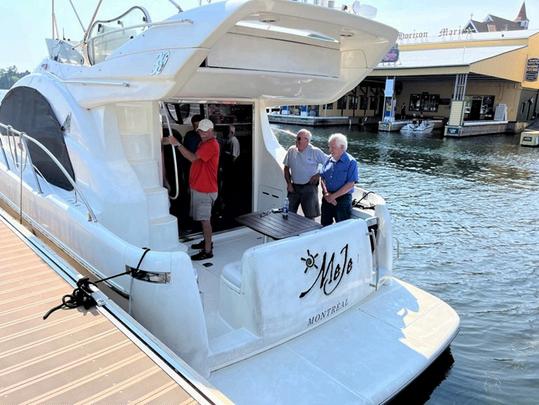
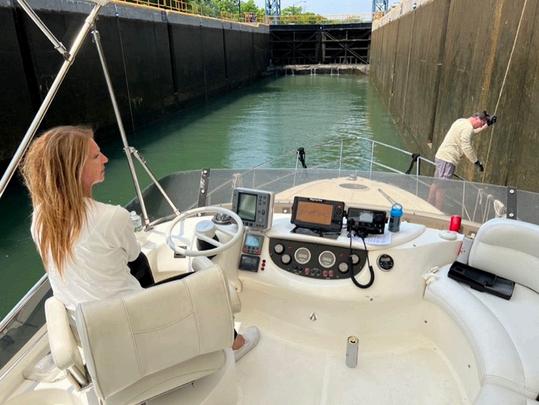
Reflecting on what we learned
As we came into Seneca Lake, a sense of accomplishment came over me In just four days, the knowledge we gained from applying what we had recently learned in our coursework was immense.
Both Jacqueline and I had handled lines and taken the helm through 18 locks with varying tethering systems. We had traveled next to gargantuan freighter ships and locked up next to small fishing boats. We saw large factories, electric power dams, beautiful castles, farms, small villages, quaint homes and towering vacation properties.
It was a perfect day to take a ride down Seneca Lake, but this ride felt different. We pulled into Seneca Lake Resorts Marina at Sampson State Park, our new home port, and Don disembarked. After an exhausting trip, we could tell that he felt the same sense of accomplishment as a teacher that we felt as students. We enjoyed sharing this experience with him and felt blessed to have his tutelage
We motored down the full length of the lake to our temporary destination, the Village Marina in Watkins Glen. The next day, we would be putting the boat on the hard so a traveling service could install bow and stern thrusters. Capt. Tom had successfully completed what was for him a familiar route in an unfamiliar boat, through long days, all the while mentoring us through the journey. He set a standard for us, with his detailed planning and ability to adeptly work through any obstacle. He gave a master class on preparedness.
This was the type of cruise that we had dreamed of and the reason that we purchased the boat. It was the reason that we signed up for courses and took the risk of diving in despite our inexperience. It was profound to see that such a cruise was possible with proper planning. We have much to learn before we can undertake such a cruise on our own, but we are over the hump and on our way toward seeing it come to fruition. We hope that our experience will encourage other newbies to take up the challenge and to know that they have fantastic resources available through America’s Boating Club | United States Power Squadrons. ■
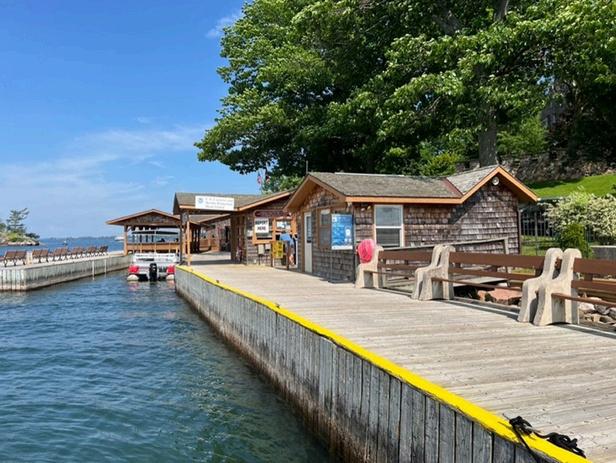
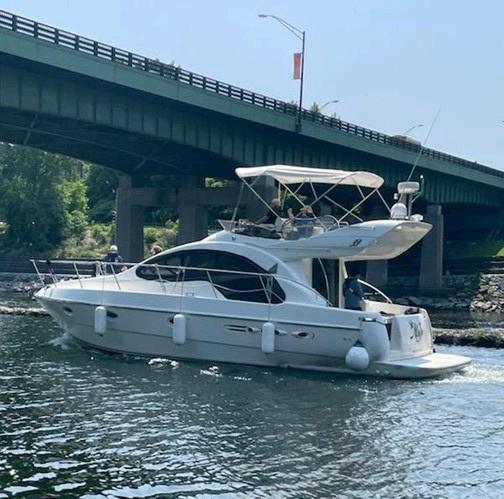
POSTSCRIPT: LEVERAGE TEAMWORK FOR RESULTS
This trip would not have been possible without the assistance of people at all levels within America’s Boating Club | United States Power Squadrons. One goal of the trip was to provide an opportunity for District 6 members to obtain advanced certification under the Boat Operator Certification program.
At the national level, we received help finding a certifier, and an Educational Fund grant helped defray transportation costs to get the certifier to our location District- and squadron-level support allowed us to coordinate the efforts of various volunteers from different squadrons to help with logistics and execution of the plan.
In the end, thanks to teamwork, we completed 12 certification activities.
The lesson? Don’t be afraid to ask for help! –Tom Alley, editor of America’s Boating Club Finger Lakes Chapter’s newsletter
ABOUT THE AUTHOR
Shane Alsworth and his wife, Jacqueline, are brand new members of America’s Boating Club and proud new owners of a 2000 Azimut 39 “baby yacht” that consumes what little free time they have. They are owners of a wealth management firm and are soon to be empty nesters as their four daughters enter various stages of adulthood.










